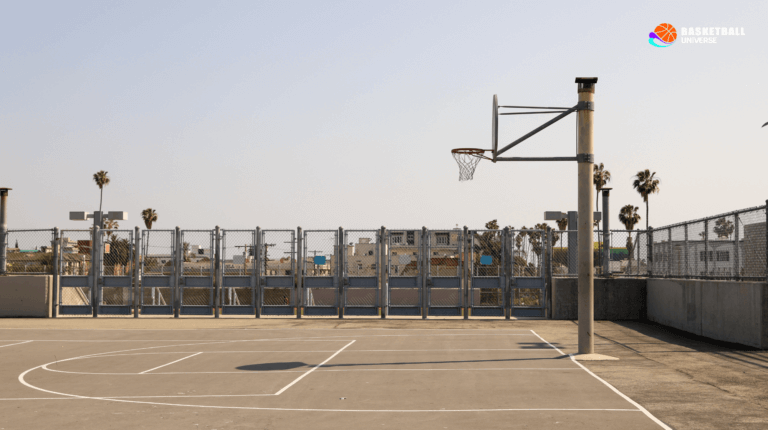
Where Is the Paint in Basketball?
Written by: Basketball Universe
Last updated:

If you’ve ever tuned in to a basketball game or set foot in a gym, chances are you’ve heard the term “paint” being thrown around. But what exactly is the paint in basketball, and why is it such a crucial aspect of the game? Step into our world as we lay down the floorboards and reveal the intricacies of this rectangular zone on the court. By the time you’re done reading, you’ll be able to name drop “the paint” like a seasoned pro and have a deeper understanding of the strategies and tactics that revolve around this vibrant and essential area of the hardwood.
Where Is the Paint in Basketball?
In basketball, the paint refers to the rectangular area on the court stretching from the baseline to the free-throw line and spanning the width of the key (the area beneath the rim). Also known as the lane, it is typically painted in a contrasting color to make it easily distinguishable, and its primary function is to serve as a strategic space for both offensive and defensive plays.
Impact of the Paint in Basketball
Now that we understand the location of the paint in basketball, let’s delve deeper into why this area of the court is so vital to player dynamics and game strategy. From scoring opportunities to defensive tactics, the paint has a dramatic effect on the ebb and flow of a basketball game.
Establishing Offensive Presence
Offensively, teams look to assert their dominance in the paint by driving the ball inside, executing quick and decisive passes, and employing strong set plays like post-ups and pick and rolls. By utilizing the paint effectively, teams create high-percentage scoring opportunities with layups, dunks, and short-range jump shots. The ability to control the paint and generate points translates into a higher level of overall offensive effectiveness.
The Role of Post Players
For post players, such as typical big men like centers and power forwards, the paint represents their primary domain. These players generally use their size, strength, and position-specific skills to establish a presence down low and generate scoring opportunities through a variety of post moves, such as hook shots, drop steps, turnaround jumpers, and offensive rebound putbacks. These positional battles in the paint prove crucial to ensuring a team’s success on both ends of the court.
Helping Draw Fouls
Attacking the paint can lead to more personal and team fouls, helping to put a squad in the “bonus” (earning additional free throws for non-shooting fouls). Free throw opportunities generated by players attacking the paint and drawing contact can be key to controlling the clock, maintain momentum during offensive droughts, and add valuable points to the scoreboard.
Defensive Importance of the Paint
In the grand scheme of basketball strategy, the impact of the paint extends beyond offensive prowess. The battle for control of this crucial strip of hardwood also swings the pendulum for defenses. Here’s how teams exert their defensive might in and around the paint:
Interior Defense
Clawing back an opponent’s ability to score in the paint is one of the primary goals of a well-balanced defense. By contesting and altering the trajectory of shots, stifling post and driving players with solid defense, and not allowing easy paths to the basket, defenders can disrupt the flow of the offense and force them to take lower-percentage outside shots.
Protecting the Rim
Rim protection is a coveted skill among basketball players, anchored by shot-blockers who expertly patrol the paint. These alley cat defenders specialize in swatting shots away from the hoop, altering opponents’ shooting angles and discouraging drives to the basket. This defensive intimidation can lead to opposing players thinking twice before attempting layups or dunks, keeping them out of the paint in the process.
Defensive Rebounding
While the offensive team strives for those coveted putbacks, it’s the defense’s goal to prevent second-chance points by controlling the paint and securing defensive rebounds. Teams that can efficiently clear the boards prevent extra possessions for the opposition and can quickly get the ball back into the hands of their offense.
The Evolution of the Paint
Just as basketball itself has changed over the years (think the introduction of the three-point line), so has the paint. As the game evolves, so does the role of the paint and the strategies associated with it. Here’s how the modern game has affected the importance of the paint:
The Emergence of Stretch 4s and Small-Ball Lineups
One of the more significant shifts in recent years has been the emergence of stretch 4s and the small-ball lineup. In traditional basketball roles, power forwards typically operated out of the post, battling for rebounds and points in the paint. However, in the modern game, power forwards are now more likely to exhibit a versatile skill set, including the ability to knock down outside shots, spread the floor, and drive to the basket. The rise of small-ball lineups, where teams employ quicker and more nimble players, has also diminished the traditional emphasis on the paint in favor of a faster pace and increased floor spacing.
The Impact of Three-Point Shooting
Another factor shaping the importance of the paint is the increasing value placed on three-point shooting. Teams now live by the long ball more than ever, focusing on spreading the floor with sharpshooters to create open looks from beyond the arc. Yet, ironically, this phenomenon has magnified the importance of the paint defensively, as denying teams access to the paint forces them to rely heavily on perimeter shooting, which ,despite the increase in shooting proficiency, still generally yields a lower shooting percentage than attempts closer to the basket. This underscores the importance of a well-balanced offensive attack that can effectively incorporate scoring inside and outside the paint.
Rules and Restrictions in the Paint
Basketball is a game of rules and systems, and understanding the limitations is just as important as knowing the benefits associated with mastering the paint:
Three-Second Rule
The three-second rule provides a vital constraint for offensive players in the paint. It dictates that players cannot remain in the paint for more than three consecutive seconds without actively attempting to move out while their team is in possession of the ball. Violating this rule results in a turnover and possession for the opposing team. This regulation forces teams to be agile and dynamic in their approach to utilizing the paint on the offensive end, preventing stagnant play and encouraging ball movement.
Restricted Area and Charging Foul
The restricted area refers to a semi-circular zone extending outward from the backboard with a radius of four feet. This area is meant to reduce collisions near the rim by discouraging defenders from planting themselves directly beneath the basket to take charges. Standing in the restricted area and attempting to draw a charge results in the defensive player being whistled for a blocking foul. By promoting safer play, the restricted area rule has become a vital part of basketball’s ongoing evolution.
A Paint-Focused Basketball Game Plan
Having covered the integral role of the paint in various aspects of basketball, let’s outline how teams can construct a paint-focused game plan to maximize success on the court:
Effective Ball and Player Movement
To successfully attack or defend the paint, it’s essential for teams to embrace effective ball and player movement. Crisp ball movement, including swift passes and smart off-the-ball play, confounds opponents while exploiting weak spots in the defense. Simultaneously, players must remain in constant motion, utilizing well-timed cuts and screens, creating space for driving lanes, and preventing the defense from focusing all their efforts on stopping the paint attack.
Creating Mismatches
Teams should capitalize on size or speed mismatches for their advantage by exploiting defensive weaknesses in the paint. For instance, offenses can involve a smaller, quicker player in a pick and roll with a bigger defender or employ a tall player in a post-up situation against a shorter opponent. These mismatches force the defense to scramble and readjust their formation, opening the door for scoring opportunities within the paint.
Utilizing Help and Team Defense
Defensive strategies that effectively counter paint attacks rely on communication and teamwork. Players must utilize help defense principles, meaning defenders maintain awareness of not only their own matchups but also the surrounding action when opponents enter the paint. By rotating and providing support when needed, defenders can apply more pressure on opponents attempting to score in the paint and prevent easy baskets.
Adapting to the Pace of the Game
A successful paint-focused game plan requires that a team adapts to the pace of the basketball game. Adjusting offensive and defensive strategies to exploit vulnerabilities in the paint necessitates a keen understanding of game flow and a willingness to make changes as needed.
In conclusion, the paint remains an integral part of basketball at all levels of play. Players who can master the various aspects of this pivotal area of the court gain a noteworthy advantage in terms of offensive opportunities, defensive effectiveness, and overall basketball IQ. By understanding the importance and nuances of the paint, fans and players alike can appreciate the beauty and complexity of the game on a deeper level.
Having delved into the significance and various aspects of the paint in basketball, it’s essential to equip yourself with practical knowledge on how to leverage this crucial area to your advantage. Let’s walk through some tips and techniques to help you navigate the paint like a pro, regardless of your position or skill level.
Mastering Footwork Fundamentals
Footwork is the cornerstone of successfully operating in the paint. Developing solid footwork fundamentals allows players to establish a strong base and effectively move both offensively and defensively. Developing skills such as pivoting, drop steps, and hop steps can significantly elevate a player’s ability to navigate the paint and create scoring opportunities.
Proper Post Positioning
Understanding proper post positioning is vital for players looking to dominate the paint. This includes sealing off defenders, recognizing when defenders are vulnerable to backdoor cuts, and recognizing open spots on the floor to exploit. Developing solid post plays such as the pick and roll, pick and pop, or high-low actions can lead to easy baskets and efficient offensive execution.
Communication is Key
Effective communication on the court is essential to create and defend scoring opportunities in the paint. Offensively, players must inform their teammates about oncoming screens, available cuts, or miscommunications within the opposition’s defense. Defensively, players need to communicate when to switch, trap, or collapse into the paint to ensure they are in sync and ready to protect the basket.
Perfecting your Touch around the Rim
Players operating in the paint require a reliable finishing touch around the rim. Developing various moves and shots – including layups, reverse layups, dunks, hooks, and floaters – allows players to adapt to different situations and maintain a potent offensive threat in the paint. Crucially, practice and repetition are key to perfecting these shots and becoming a consistent finisher.
Developing a Defensive Mindset
A strong defensive mindset is crucial for both players and teams looking to excel in the paint. This includes adopting an aggressive approach to boxing out, contesting shots without fouling, and effectively rotating as a unit to cover driving lanes and close down on potential scorers. Developing a lockdown defense in the paint can suppress the opposing team’s offensive threats and generate fast-break opportunities.
Strength Training and Conditioning in the Paint
To compete and thrive in the paint, a strong foundation in physical strength and conditioning is vital. Players looking to improve their skills in the paint should focus on targeted training regimes that allow them to be more explosive while also staying agile and adaptable.
Strength Training
Strength is a vital component when operating in the paint. Players can benefit from incorporating exercises such as squats, lunges, deadlifts, bench presses, and push-ups into their training routines to build power, allowing for a solid base and increasing control within the paint.
Conditioning and Agility
While strength is important, agility and conditioning should not be overlooked. Players should regularly engage in conditioning exercises that involve sprints, high-intensity interval training, and plyometric exercises. Adding agility training, such as ladder drills or cone drills, can help hone quickness and create more dynamic movement within the paint.
Vertical Leap
A high vertical leap is an asset for players who want to excel in the paint. Exercises like box jumps, depth jumps, and split squat jumps help improve overall explosiveness, allowing players to gather rebounds, block shots, and convert high-flying dunks.
By incorporating these tips and strategies, players can elevate their game and become a formidable force in the paint. The invaluable ability to contribute to a team’s offensive and defensive prowess will emerge as a result of cultivating the essential skills and techniques required to make a significant impact in the paint.
Frequently Asked Questions
If you’re still curious about all things related to the paint in basketball, don’t worry! We’ve got you covered. Check out our list of frequently asked questions (FAQs) to satisfy your curiosity and deepen your understanding of this essential aspect of the game.
1. What is the size of the paint in basketball?
The dimensions of the paint differ across leagues and playing levels. In the NBA, the key measures 16 feet wide, while in the NCAA and FIBA, the key is 12 feet wide. The paint extends from the baseline to the free-throw line, which is typically 15 feet from the backboard.
2. Why is the paint an essential area for teams to control?
Managing the paint area is crucial for teams, as it is the section on the court where high-percentage scoring opportunities like layups, dunks, and short-range shots are most likely to occur. Additionally, controlling the paint means dictating the flow of the game both offensively and defensively, creating a strategic advantage.
3. How can I improve my skills in the paint?
To improve your skills in the paint, focus on developing footwork fundamentals, proper post positioning, communication, and a reliable finishing touch. Also, invest time in strength training, conditioning, and agility exercises.
4. Can guards be effective in the paint?
Yes, guards can be effective in the paint. Although they may not possess the size and strength of post players, they can utilize their agility, quickness, and crafty ball-handling skills to exploit mismatches and create scoring opportunities in the paint.
5. What are the rules associated with the paint in basketball?
The two main rules associated with the paint are the three-second rule, which prevents offensive players from spending more than three consecutive seconds in the paint without making a shot, and the restricted area rule, which discourages defenders from taking charges directly beneath the basket.
6. How has the role of the paint changed in modern basketball?
The role of the paint has evolved as the game places more emphasis on versatile frontcourt players who can spread the floor and shoot from the perimeter. However, the paint’s significance remains consistent as a crucial strategic area for creating high-percentage scoring opportunities and dictating the game’s pace.
7. Why is rim protection important in the paint?
Rim protection is crucial because it involves contesting and altering opponents’ shots, leading to lower shooting percentages and fewer easy baskets. Shot blockers in the paint also deter opponents from attempting layups and dunks, making them hesitate around the rim.
8. Can I improve my vertical leap to be more effective in the paint?
Yes, working on your vertical leap can enhance your effectiveness in the paint. Incorporating exercises such as box jumps, depth jumps, and split squat jumps into your training can help develop your explosiveness, allowing for better rebounding, shot-blocking, and finishing around the rim.
9. What are some examples of offenses utilizing the paint?
Examples of offenses leveraging the paint include executing pick and rolls, quick interior passes, post plays, and driving into the paint to create opportunities for layups, dunks, or short-range shots.
10. How should defenses approach guarding the paint?
Defenses should focus on contesting shots, cutting off driving lanes, providing help defense, and maintaining proper defensive positioning. Effective communication and constant player adjustments are also essential to deter opponents from scoring in the paint.
11. What is the “restricted area” in the paint?
The restricted area is a semi-circular zone extending from the backboard with a radius of four feet. Its purpose is to reduce collisions and injuries by preventing defenders from taking charges directly beneath the basket.
12. How does attacking the paint help draw fouls?
Driving to the basket forces defenses to contest shots, leading to increased chances of making contact and committing fouls. This can result in additional free throw opportunities and may put the opposing team in foul trouble or the “bonus.”
13. Is the paint equally important in all levels of basketball?
Yes, the paint remains a critical aspect of the game across all levels of basketball, from youth and amateur leagues to professional play. Learning to utilize the paint strategically and effectively can vastly improve a player’s skills and enhance their team’s overall performance.
Featured Posts
- No pillar pages found.




